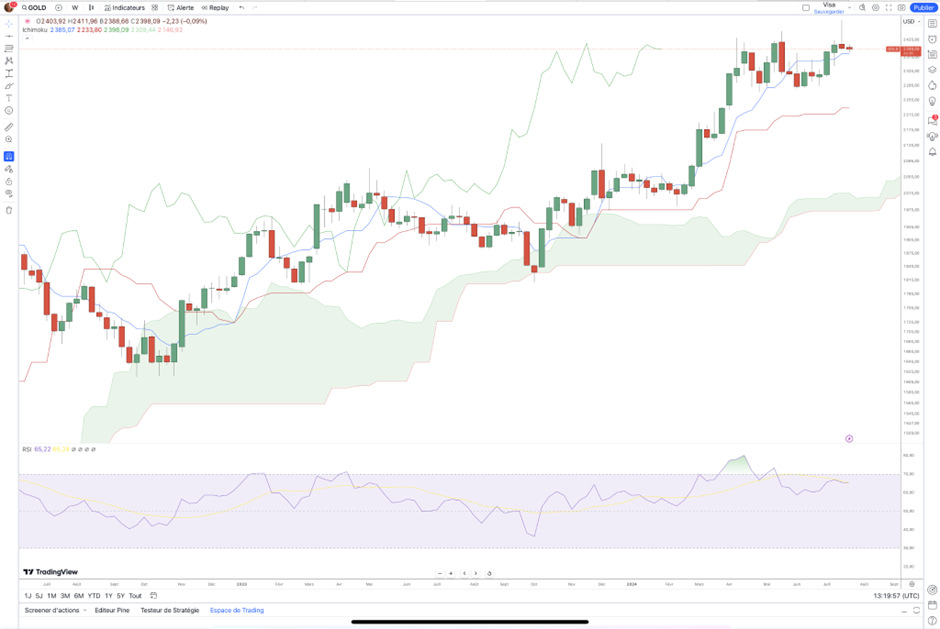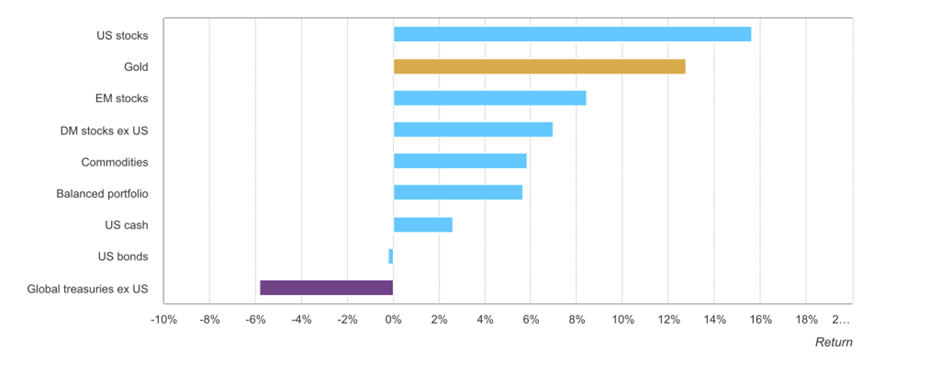Gold Down More Than 3.70% Since Record High
Gold prices took a wild turn this week! After reaching a record high of $2,483.56 per ounce on July 17th according to ActivTrades' data, gold shed nearly 4% in just four days. Today, they sit around $2,390.13 per ounce.

Weekly Gold Prices - Sources: TradingView with ActivTrades Data
What caused this sudden drop, and what's next for gold traders? Let's delve into the factors behind this rollercoaster ride.
Why Did Gold Prices Reach a New All-Time High Last Week?
The Federal Reserve has been holding the federal funds rate at a historically high target range of 5.25% to 5.50% since July 2023. This aggressive stance aimed to combat high inflation, which peaked at a staggering 9.1% – a 40-year high.
Inflation has cooled somewhat, hovering around 3% for the past year. Additionally, rising unemployment and potentially slower GDP growth raise concerns about potential economic stagnation if the Fed doesn't ease its grip.
This evolving economic landscape has fueled market expectations of an upcoming significant policy shift. Financial markets are increasingly confident that rate cuts will begin in September, with some economists even predicting a reduction in July. This anticipation has pushed the US dollar lower and boosted gold prices.
While the Fed seems to be acknowledging the need for lower rates, they remain cautious. Policymakers emphasise the need for more economic data to confirm a sustained decline in inflation before adjusting policy. This suggests a gradual approach rather than an immediate, aggressive rate cut.
Morningstar’s analysts expect significant rate cuts over the next two to three years, potentially bringing the federal funds rate down to 1.75% to 2.00% by the end of 2026.
However, uncertainty remains. While some policymakers are more comfortable with the inflation trajectory, others might advocate for maintaining a tighter monetary policy for a longer period.
The key question for the Fed lies in achieving a delicate balance: easing inflation without triggering a recession by allowing unemployment and slower growth to spiral out of control.
In the coming week, the Fed's decision will be closely watched by financial markets. But what’s the link between these rate cut anticipation and the gold price spike?
Lower interest rates generally make gold a more attractive investment compared to interest-bearing assets like bonds. When rates fall, the opportunity cost of holding non-yielding gold diminishes, potentially leading to increased demand and a price rise.
Additionally, lower interest rates exert downward pressure on the American dollar, which strengthens the relative attractiveness of gold.
Gold prices are indeed typically quoted in US dollars (USD) per ounce, which means that a weaker US dollar (USD losing value against its major peers) means it takes more dollars to buy the same amount of gold for those holding foreign currencies, which can translate to an increase in the gold price (priced in USD).
U.S. President Joe Biden's Withdrawal from the 2024 Presidential Race Initially Boosts Gold Prices on Monday
Following the surprise decision made by President Joe Biden of the United States to withdraw his candidature for the presidency of the United States in 2024, gold prices increased on Monday morning as the dollar saw a decline during the Asian trading sessions. A new wave of uncertainty has been introduced into the financial markets as a result of this huge political event, which has prompted investors to look for stability.
As a consequence of this, a great number of investors have resorted to gold, which is a well-established safe-haven asset, in order to protect their funds from the unpredictability of the political and economic environment. Gold prices have however lost ground during the course of the trading day, despite the fact that they originally gained almost 0.30%.
The increased demand for gold during times of uncertainty highlights the essential role that gold plays as a hedge during moments of instability. This demand is a reflection of worries over the potential repercussions that Biden's departure may have on the dynamics of the market in the future.
In times like these, investors search for ways to safeguard their wealth by putting their money into assets that are seen as being trustworthy and stable. The inherent worth of gold, in addition to its historical function as a store of wealth, makes it an appealing choice during times of economic instability.
Additionally, investors frequently diversify their portfolios in order to lessen risk during times of market volatility and instability. Due to the fact that gold often has a low correlation to other asset classes such as equities and bonds, it is an efficient instrument for diversification.
When investors include gold in their portfolios, they intend to reduce the risk of incurring losses from other assets, which ultimately results in an increase in their total financial stability during times of uncertainty.
Gold Shines as One of 2024's Top Performing Assets
After having gained 1.74% in 2022 and 13.17% in 2024, Gold is up more than 16% so far in 2024.

Annual Performance of Gold and Major Asset Classes in USD - Sources: Bloomberg, World Gold Council With Data as of 30 June 2024
The World Gold Council's Mid-Year Outlook 2024 dives into the factors fueling gold's rise in 2024. Central banks remain active buyers, Asian investors are pouring in, consumer demand stays steady, and geopolitical uncertainty continues to simmer, all contributing to gold's positive performance.
But what's next for gold? The future trajectory of this metal hinges on a complex interplay of factors… What do you think will happen?
The information provided does not constitute investment research. The material has not been prepared in accordance with the legal requirements designed to promote the independence of investment research and as such is to be considered to be a marketing communication.
All information has been prepared by ActivTrades (“AT”). The information does not contain a record of AT’s prices, or an offer of or solicitation for a transaction in any financial instrument. No representation or warranty is given as to the accuracy or completeness of this information.
Any material provided does not have regard to the specific investment objective and financial situation of any person who may receive it. Past performance is not a reliable indicator of future performance. AT provides an execution-only service. Consequently, any person acting on the information provided does so at their own risk.













